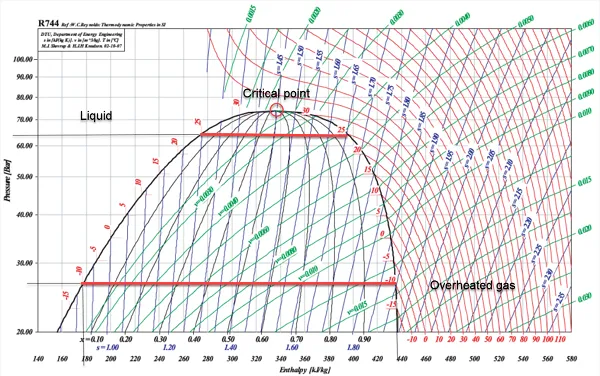-1920x996.png&width=2000)
Choosing natural refrigerants | Carbon Dioxide (CO2)
Choosing natural refrigerants | Carbon Dioxide (CO2)
R744 CO2
Natural refrigerants are a hot topic. More and more onshore utility-based installations are switching to natural gas. What’s the situation in the maritime industry? Selecting the right refrigerant is no easy task as each type has its own pros and cons. In this blog series we will explore the most common natural refrigerants so you can understand which one best suits your specific application.
Today we take a closer look at R744 or CO2. This refrigerant has been in use since the early days of refrigeration in the 19th century and is nothing more than the natural gas carbon dioxide. Naturally present in the earth’s atmosphere and crucial for life on earth, CO2 consists of one carbon atom and two oxygen atoms.
To give you a comprehensive overview we are comparing every refrigerant on the following fixed set of properties:
| Thermodynamic properties | Safety | Sustainability |
| Temperatures | Flammability | GWP |
| Pressures | Toxicity | Ozone depletion |
| Latent heat capacity | Pressure | Energy efficiency |
| Corrosive |
All starting points are the same for every refrigerant, including the temperatures below:
Evaporation temperature: -10°C
Condensation temperature: 25°C
Overheating 20K
Subcooling 5K

Figure 1: H-log/P diagram R744 (CO2)
Thermodynamic properties
The first thing you will notice with R744 is the low critical temperature and high pressures. The critical point is found at the top of the curve (see figure 1). Above this temperature and pressure a condenser cannot condense the refrigerant and a gas cooler is needed.
- Evaporation and condensation temperature
R744 has a temperature range with its critical point at 31.1°C so the refrigerant can be subcritically applied for lower temperature applications. In regions with higher ambient or (sea)water temperature the system needs to be designed for transcritical application. - Evaporation and condensation pressure
Another thing you will notice are the high pressures, especially compared to conventional refrigerants. At -10°C the pressure is already around 25 bar, reaching 65 bar at 25°C. - Latent heat capacity
R744 has a good latent heat capacity, especially compared with R22 and R404a. Follow the -10°C line in figure 1 and you see an enthalpy difference of 258 kJ/kg.
Safety
Looking at the safety classification, R744 has favourable properties compared to other natural refrigerants. It is classified as A1: non-flammable.
|
Safety group |
Lower toxicity |
Higher toxicity |
| High flammability |
A3 |
B3 |
| Flammable |
A2 |
B2 |
| Lower flammability |
A2L |
B2L |
| No flame propagation |
A1 |
B1 |
- Flammability
Non-flammable. - Toxicity
Non-toxic. Like every other refrigerant, CO2 can cause suffocation. - Pressure
Systems running on R744 operate at pressures varying from 30 to 90 bar (even higher when transcritical). - Corrosion
Non-corrosive
Sustainability
CO2 scores high on the sustainability ranking. With low GWP and ozone depletion values, leakages have hardly any effect on the environment.
- GWP & ozone depletion
The global warming potential of CO2 is 1. It makes a negligible contribution to the greenhouse effect compared to other refrigerants. The ozone depletion capacity is equal to 0 so emissions have no effect on the ozone layer. - Energy efficiency
The energy efficiency depends on the design at specific temperatures. For an accurate comparison we use the same temperature value for each refrigerant as specified above. Based on these conditions the EER is 3.2, which is an last in the row. This can of course be improved with smart system design.
Conclusion
CO2 is somewhat tricky to compare to other refrigerants. When used with the low seawater temperatures found in the North Atlantic, North and Baltic seas, the system is comparable to conventional refrigerants. At higher seawater temperatures, however, the installation needs to be designed for transcritical applications. This requires a completely different and far more advanced machine. CO2 is not flammable or toxic and has little to no impact on the environment.
Please note that the values and calculation given in this article have been simplified in order to give you a general view of all the pros and cons of this refrigerant. More specific information is needed for a detailed calculation and we strongly recommend contacting one of our engineers if you’re considering the use of natural refrigerants.
Want to learn more about natural refrigerants? You can download our extensive whitepaper here.